Enhancing aqm to combat wireless losses
a technology of aqm and wireless loss, applied in the field of enhancing aqm to combat wireless losses, can solve the problems of system disturbances such as wireless losses, and achieve the effect of stabilizing the backlog and reducing the problem of backlog instability
- Summary
- Abstract
- Description
- Claims
- Application Information
AI Technical Summary
Benefits of technology
Problems solved by technology
Method used
Image
Examples
example 1
[0083]Consider the scenario illustrated in FIG. 1, with the wireless link of capacity 15 Mbps and propagation delay of 50 ms. A data packet is 1000 bytes long, and thus cl=1875 packets / second. A total of N=100 homogeneous TCP flows share the link. Suppose that the equilibrium queue size is bl=220 packets. For ease of comparison, bl is determined in accordance with the equilibrium level achieved by RED without wireless losses. Nevertheless, for other reasonable values of bl (generally, greater than N and less than the buffer size), all the computations follow similarly and the discussions about the IC continue to hold. It follows that df is around 0.2 seconds.
[0084]Applying the concepts in the article, G. Vinnicombe, “On the Stability of Networks Operating TCP-Like Congestion Control,”Proc. of the IFAC World Congress on Automatic Control, June 2002. (24) and using d+=0.2 seconds, N−=N=100, and c=cl=1875 packets,
g≤0.8·10030.25·18753≈0.3793
example 2
[0085]Consider another network scenario illustrated in FIG. 5, which consists of three wired local area networks (LANs) 40, 50, 60 inter-connected to create a wide area network (WAN) via wireless links. Three sets of flows F1, F2, and F3 share the network. There are N1=60, N2=50, and N3=20 flows in F1, F2, and F3, respectively. Flows within the same set are homogeneous. Each of the flows in Fi (i=1, 2, 3) traverses from Sij to Dij, where 1≦j≦60 for i=1, 1≦j≦50 for i=2, and 1≦j≦20 for i=3. Thus, there are two wireless bottleneck links whose dynamics are coupled via flows in F3. Suppose that the equilibrium queue sizes of both wireless links are b1=b2=200 packets. Let di and Wi be the equilibrium RTT and window size for each of the flows in Fi, respectively. It follows that:
[0086]c=(1600, 1200) packets / second
[0087]d≈(0.18, 0.22, 0.35)T seconds
[0088]W≈(4.2, 4.5, 3.2)T packets
and thus ∥{circumflex over (R)}F(0)∥1≈0.017.
[0089]Now, the matrix {circumflex over (R)}F(0){circumflex over (R)}...
PUM
 Login to View More
Login to View More Abstract
Description
Claims
Application Information
 Login to View More
Login to View More - R&D
- Intellectual Property
- Life Sciences
- Materials
- Tech Scout
- Unparalleled Data Quality
- Higher Quality Content
- 60% Fewer Hallucinations
Browse by: Latest US Patents, China's latest patents, Technical Efficacy Thesaurus, Application Domain, Technology Topic, Popular Technical Reports.
© 2025 PatSnap. All rights reserved.Legal|Privacy policy|Modern Slavery Act Transparency Statement|Sitemap|About US| Contact US: help@patsnap.com



